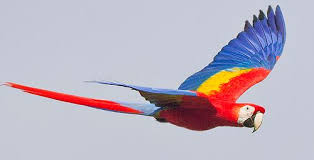The scarlet macaw is a large red, yellow, and blue South American parrot, a member of a large group of
Neotropical parrots called macaws. It is native to humid evergreen forests of tropical South America. Range
extends from extreme south-eastern Mexico to Amazonian Peru, Colombia, Bolivia, Venezuela and Brazil in
lowlands up to 500 m (1,640 ft) (at least formerly) up to 1,000 m (3,281 ft). It has suffered from local
extinction through habitat destruction and capture for the parrot trade, but locally it remains fairly
common. Formerly it ranged north to southern Tamaulipas. It can still be found on the island of Coiba. It is
the national bird of Honduras.
Description
It is about 81 centimetres (32 in) long, of which more than half is the pointed, graduated tail typical of
all macaws, though the scarlet macaw has a larger percentage of tail than the other large macaws. The average
weight is about 1 kilogram (2.2 lb). The plumage is mostly scarlet, but the rump and tail-covert feathers
are light blue, the greater upper wing coverts are yellow, the upper sides of the flight feathers of the
wings are dark blue as are the ends of the tail feathers, and the undersides of the wing and tail flight
feathers are dark red with metallic gold iridescence. Some individuals may have green in the wings.
There is bare white skin around the eye and from there to the bill. Tiny white feathers are contained on the
face patch. The upper mandible is mostly pale horn in color and the lower is black. Juveniles have dark
eyes; adults have light yellow eyes.
It is frequently confused with the slightly larger green-winged macaw, which has more distinct red lines in
the face and no yellow in the wing.
Scarlet macaws make very loud, high and sometimes low-pitched, throaty squawks, squeaks and screams designed
to carry many miles to call for their groups.
The scarlet macaw can live up to 75 years in captivity, although a more typical lifespan is 40 to 50
years.
Behavior
A typical sighting is of a single bird or a pair flying above the forest canopy, though in some areas flocks
can be seen. They may gather at clay licks. Scarlet macaws communicate primarily through raucous honks;
however, vocal communication is highly variable, and captive macaws are known to be adept mimics of human
speech.
Feeding
Scarlet macaws eat mostly fruits, nuts and seeds, including large, hard seeds.
Breeding
While comparatively docile at most times of the year, scarlet macaws may be formidably aggressive during
periods of breeding. Scarlet macaws are monogamous birds, with individuals remaining with one partner
throughout their lives. The hen lays two or three white eggs in a tree cavity. The female incubates the
eggs for about five weeks, and the chicks fledge from the nest about 90 days after hatching. and leave
their parents about a year later. Juveniles reach sexual maturity at five years of age.
Distribution and habitat
The South American range is extensive and covers the Amazon basin; extending to Peru east of the Andes, to
Bolivia.
In Central American the range extends from extreme eastern and southern Mexico and Panama through Guatemala
and Belize, the island of Coiba and infrequently on the mainland of Panama, and two isolated regions on the
Pacific Coast of Costa Rica; the Carara National Park and Peninsula de Osa.
Scarlet macaws inhabit humid lowland subtropical rain forests, open woodlands, river edges, and savannas.








